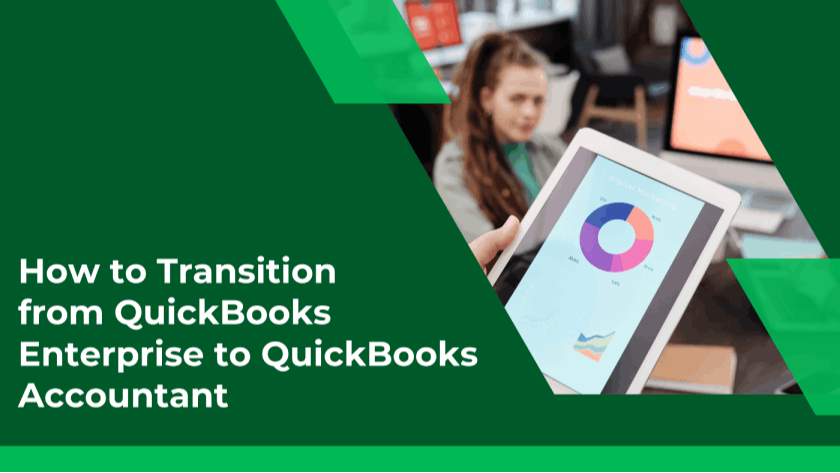-
 11183 Stone brook Dr. Manassas VA 20112
11183 Stone brook Dr. Manassas VA 20112
-
 Mon-Fri : 09:30 Am - 06:24 Pm
Mon-Fri : 09:30 Am - 06:24 Pm
 25 February 2025
25 February 2025
Switching from QuickBooks Enterprise to QuickBooks Accountant is a common choice for businesses and accounting professionals looking for more specialized financial management features. Whether you are an accountant handling multiple client accounts or a business seeking a more tailored accounting solution, transitioning between these platforms requires a structured approach. This comprehensive guide will help ensure a smooth and error-free conversion while preserving the accuracy of your financial data.
QuickBooks Enterprise and QuickBooks Accountant serve different purposes. QuickBooks Enterprise is designed for larger businesses that require advanced inventory tracking, in-depth reporting, and multiple user access. On the other hand, QuickBooks Accountant is specifically built for accounting professionals who need efficient tools to manage multiple clients' financial records. The transition from QuickBooks Enterprise to QuickBooks Accountant involves exporting your company data and importing it into the new software while ensuring data integrity.
Before making any modifications to your accounting software, it is essential to create a backup of your current data. A backup ensures that you can restore your original files in case anything goes wrong during the transition.
To create a backup in QuickBooks Enterprise:
Launch QuickBooks Enterprise and navigate to the File menu.
Click on Back Up Company and select Create Local Backup.
Follow the instructions displayed on the screen to save a copy of your company file in a secure location.
Before beginning the migration process, confirm that your version of QuickBooks Accountant is compatible with your current QuickBooks Enterprise data file. Using the most recent version of both software platforms is highly recommended to prevent data loss or compatibility issues.
The first step in the conversion process is to prepare and export your data from QuickBooks Enterprise.
Open QuickBooks Enterprise on your computer.
Navigate to the Company menu and select Export Company File to QuickBooks Online.
Follow the on-screen instructions to complete the export process. During this step, QuickBooks may prompt you to clean up or adjust certain data that may not be compatible with the new software.
Once your data has been successfully exported from QuickBooks Enterprise, the next step is to import it into QuickBooks Accountant.
Launch QuickBooks Accountant on your system.
Go to the File menu and click Open or Restore Company.
Select Restore a backup copy, then choose Local backup.
Find the backup file you saved from QuickBooks Enterprise, select it, and proceed with the restoration process.
Follow the guided steps to complete the import process, ensuring that all data fields are correctly mapped to match QuickBooks Accountant’s format.
After the import is finished, carefully review your financial records, transactions, and account details to ensure everything has been transferred correctly and matches the original data.
Compare financial reports from QuickBooks Enterprise and QuickBooks Accountant to detect any discrepancies.
Review customer lists, vendor records, and employee details to ensure that all information is correct and up to date.
If you find any missing or inaccurate data, you may need to manually adjust the records or re-import specific sections of your data.
After completing the data transfer, take some time to customize QuickBooks Accountant according to your business or accounting needs. This includes updating user preferences, modifying report templates, and setting up specific workflow automations that streamline accounting tasks.
If your business has multiple users who rely on QuickBooks, ensure that they are aware of the software transition. Provide training sessions to help them get familiar with QuickBooks Accountant’s features, navigation, and tools. Understanding the new system will improve efficiency and reduce potential errors in financial reporting.
Transitioning from QuickBooks Enterprise to QuickBooks Accountant is a strategic decision that requires careful planning and execution. By following the outlined steps—backing up data, ensuring software compatibility, exporting and importing financial records, and verifying data accuracy—you can successfully migrate to the new platform without disruptions.
At QB Advisors LLC, we specialize in providing professional assistance for QuickBooks conversions, ensuring a seamless and hassle-free transition. If you need expert support, guidance, or troubleshooting during the process, our team is ready to assist. Stay updated with the latest QuickBooks features and maintain regular data backups to safeguard your financial records.
For professional QuickBooks support, contact QB Advisors LLC today.